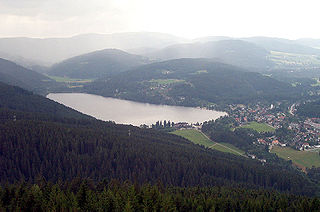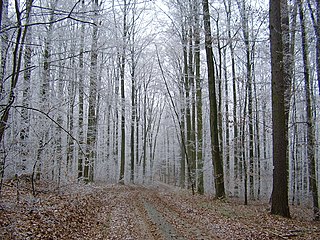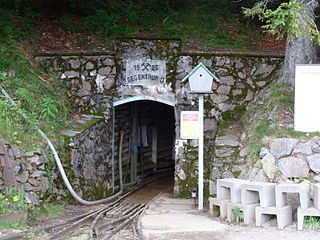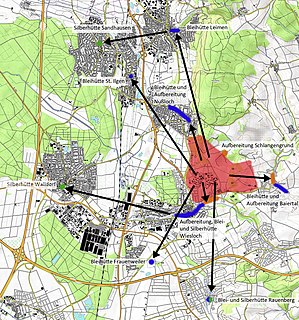
The Black Forest is a large forested mountain range in south-west Germany, in the state of Baden-Württemberg, bounded by the Rhine valley to the west and south and close to the borders with France and Switzerland. It is the source of the Danube and Neckar rivers.

Uraninite, formerly pitchblende, is a radioactive, uranium-rich mineral and ore with a chemical composition that is largely UO2 but because of oxidation typically contains variable proportions of U3O8. Radioactive decay of the uranium causes the mineral to contain oxides of lead and trace amounts of helium. It may also contain thorium and rare-earth elements.

The Titisee is a lake in the southern Black Forest in Baden-Württemberg. It covers an area of 1.3 km2 and is an average of 20 m (66 ft) deep. It owes its formation to the Feldberg glacier, the moraines of which were formed in the Pleistocene epoch and nowadays form the shores of the lake. The lake's outflow, at 840 m (2,760 ft) above sea level, is the River Gutach, which merges with the Haslach stream below Kappel to form the Wutach. The waters of the Titisee thus drain eventually into the Upper Rhine between Tiengen and Waldshut. On the north shore lies the spa town of the same name, today a part of the municipality of Titisee-Neustadt.

Uranium mining is the process of extraction of uranium ore from the ground. The worldwide production of uranium in 2019 amounted to 53,656 tonnes. Kazakhstan, Canada, and Australia were the top three uranium producers, respectively, and together account for 68% of world production. Other countries producing more than 1,000 tonnes per year included Namibia, Niger, Russia, Uzbekistan, the United States, and China. Nearly all of the world's mined uranium is used to power nuclear power plants. Historically uranium was also used in applications such as uranium glass or ferrouranium but those applications have declined due to the radioactivity of uranium and are nowadays mostly supplied with a plentiful cheap supply of depleted uranium which is also used in uranium ammunition. In addition to being cheaper, depleted uranium is also less radioactive due to a lower content of short-lived 234
U and 235
U than natural uranium.

Geislingen is a town in the Zollernalbkreis district of Baden-Württemberg, Germany. It is situated 4 km northwest of Balingen. The population stands at roughly 6,000. Geislingen includes three smaller towns, Geislingen, Erlaheim, and Binsdorf, all of them growing about 1% per year. The area has been continuously settled since the Stone Age. The first written documentation of Binsdorf came in 834, Geislingen was officially mentioned in 1188. The local economy mixes agriculture with services and small-scale industry. Many residents work in industrial areas south of Stuttgart or in nearby Balingen.

SAG/SDAG Wismut was a uranium mining company in East Germany during the time of the cold war. It produced a total of 230,400 tonnes of uranium between 1947 and 1990 and made East Germany the fourth largest producer of uranium ore in the world at the time. It was the largest single producer of uranium ore in the entire sphere of control of the USSR. In 1991 after German reunification it was transformed into the Wismut GmbH company, owned by the Federal Republic of Germany, which is now responsible for the restoration and environmental cleanup of the former mining and milling areas. The head office of SDAG Wismut / Wismut GmbH is in Chemnitz-Siegmar.

The Belchen, 1,414 metres (4,639 ft), or Black Forest Belchen is the fourth-highest summit of the Black Forest after Feldberg, Seebuck and Herzogenhorn. The municipalities of Münstertal, Schönenberg and Kleines Wiesental meet on the summit dome of Belchen which is located in the southwest German state of Baden-Württemberg.

The Herzogenhorn is a mountain, 1,415.2 m above sea level (NHN), in the southwest German state of Baden-Württemberg. It lies within a nature reserve in the municipality of Bernau im Schwarzwald.

Minium is the naturally occurring form of lead tetroxide, Pb2+2Pb4+O4 also known as red lead. Minium is a light-to-vivid red and may have brown-to-yellow tints. It typically occurs in scaly-to-earthy masses. It crystallizes in the tetragonal crystal system.

Morassina is an inactive mine in Schmiedefeld (Lichtetal), Thuringia, Germany. Today it is a tourist attraction known for its stalactites.

The Alb is a river in the Northern Black Forest in Germany. It is a tributary of the Rhine, and flows through the cities of Karlsruhe, Ettlingen and Bad Herrenalb.

The Black Forest National Park is a national park in the state of Baden-Württemberg in the southwest of Germany.

Schwabenhass is a neologism referring to the aversion to the approximately 300,000-strong Swabian diaspora in Berlin and elsewhere in Germany outside of Swabia. In 2013, the so-called Spätzle-streit gained nationwide attention.

The Baroque fortifications in the Black Forest, also called Baroque Schanzen (Barockschanzen) or Black Forest lines (Schwarzwaldlinien), are historical, military earthworks, known as schanzen, that were built in the Black Forest in what is now Germany. They were built in the 17th century to defend the Margraviate of Baden from French invasion. Together with their adjoining defensive lines, the Black Forest fortifications formed a defensive system over 200 kilometres (120 mi) long that ran from north to south.

The Harthausen Forest is a large forested area that – depending on the definition used – is 20 to over 30 km² in area. It lies in the north of Baden-Württemberg between the valleys of the lower reaches of the Jagst and Kocher on a hill ridge which is up to 334 m above sea level (NN). The largest part of the forest lies on the territory of Hardthausen am Kocher and thus in the county of Heilbronn, a smaller part in the east is in Hohenlohekreis.

The Schauinsland Pit was a silver and lead mine east of Freiburg im Breisgau. From the 19th century zinc was also mined. The mine operated from the 13th century until 1954. Since 1997 Schauinsland Pit has been a show mine.
Menzenschwand is a climatic health spa in the Black Forest in Germany. The village lies within the borough of St. Blasien in the state of Baden-Württemberg.

The Finstergrund Pit near Wieden in the Black Forest in Germany is an abandoned medieval silver and lead mine that was also used in the modern era to extract fluorite and baryte. Since 1982 it has been used as a visitor mine.

The Caroline Pit in the Eberbächle, a side valley of the Brettenbach, is an old silver mine in Sexau in the Black Forest in Germany which is open to the public as a show mine. In 1987, volunteers began to uncover the pit and maintain it. It lies within the mining region of Sexau and Freiamt.

The area around Wiesloch, Germany, is a historical centre for mining, running between Roman times and the earlier 2000s. The area is situated on the eastern edge of the Upper Rhine Plain and contains large concentrations of carbonate-hosted lead-zinc ore deposits. Lime for cement is still actively mined in the vicinity, with most of the clay pits closed, and the last heavy metal mine operated until 1953 by Stolberger Zink. On top of the escarpment metals and lime have been mined, with clay and sand mined at the end of the valley floor where faulting has brought different layers closer to the surface.


















